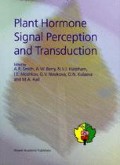Abstract
Synthetic peptides have found increasing use in dissecting cell signalling pathways and have been employed as synthetic antigens, protein kinase and protease substrates. Recently, it has become evident that relatively short (10–30mer) peptides are able to mimic that part of the signalling protein to which their sequence corresponds. In particular, peptides corresponding to the C-terminus of Zea mays auxin binding protein, ZmABPl, were able to modulate ion channel function within Vicia guard cells. In this report, GTPγS binding to NaCl-washed Zea microsomal membranes is shown to be stimulated by peptide A6.2, corresponding to the C-terminal 16 residues of ZmABPl, only when the membranes are reconstituted with soluble Zea protein fractions containing GPal and Gao homologues.
Access this chapter
Tax calculation will be finalised at checkout
Purchases are for personal use only
Preview
Unable to display preview. Download preview PDF.
References
Barbier-Brygoo H, Ephritikine G, Klämbt D, Maurel C, Palme K, Schell J and Guem J (1991) Perception of the auxin signal at the plasma membrane of tobacco mesophyll protoplasts. The Plant J 1: 83–93
Bilushi SV, Shebunin AG and Babakov AV (1991) Purification and subunit characterisation of a GTP binding protein from maize root plasma membranes. FEBS Lett. 291: 219–221
Cheung AH, Huang RRC, Graziano MP and Strader, CD (1991) Specific activation of Gs by synthetic peptides corresponding to an intracellular loop of the beta-adrenergic receptor. FEBS Lett 279: 277–280
Conklin BR and Bourne HR (1993) Structural elements of Ga subunits that interact with Gβγ, receptors and effectors. Cell 73:631–641
de Boer AH van Honnike E, Korthout HAAJ, Sedd NJA and Wang M (1994) Affinity purification of GTPase proteins from oat root plasma membranes using biotinylated GTP. FEBS Lett. 337:281–284
Fricker MD, White NS, Theil G, Millner P and Blatt MR (1994) Peptides derived from the auxin binding protein C-terminus elevate Ca2+ and pH in stomatal guard cells of Vicia faba: a confocal fluorescence ratio imaging study. SEB Symposium 48: 215–228
Goldsmith P, Gierschik K, Milligan G, Unson CG, Vinitsky R, Malek HL and Speigel AM (1987) Antibodies directed towards synthetic peptides distinguish between GTP-binding proteins in neutrophil and brain. J Biol Chem 262: 14683–14688
Hesse T, Feldwisch J, Balschüseman D, Bauw G, Puype M, Vandekerkhove J, Löbler M, Klämbt D, Schell J and Palme K (1989) Molecular cloning and structural analysis of a gene from Zea mays(L.) coding for a putative receptor for the plant hormone auxin. EMBO J 8: 2453–2461
Inohara N, Shimomura S, Fukui T and Futai M (1989) Auxin binding protein located in the endoplasmic reticulum of maize shoots: Molecular cloning and complete primary sequence. Proc Natl Acad Sci USA 86: 3564–3568
Jo H, Radding W, Anantharamaiah GM and McDonald JM (1993) An insulin receptor peptide (1135–1156) stimulates guanosine 5′-[γ-thio] triphosphate binding to the 67 kDa G-protein associated with the insulin receptor. Biochem J 294: 19–24
Klämbt D (1991) A view about the function of auxin binding proteins at plasma membranes. PI Mol Biol 6: 1045–1053
Luttrell LM, Ostrowski J, Cotecchia S, Kendall H and Lefkowitz RJ (1993) Antagonism of catecholamine receptor signalling by expression of cytoplasmic domains of the receptors. Science 259: 1453–1457
Millner PA, White IR, Groarke DA, Theil G and Blatt MR (1994) Novel strategies towards an auxin evoked transport control. SEB Symposium 48: 203–213
Mumby SM, Kahn RA, Manning DR and Gilman AG (1986) Antisera of designed specificity for subunits of guanine nucleotide-binding regulatory proteins. Proc Natl Acad Sci USA 83: 265–269
Napier RM and Venis MA (1991a). From auxin binding protein to plant hormone receptor. Trends in Biochem Sci 16: 72–75
Napier RM and Venis MA (1991b). Monoclonal antibodies detect an auxin induced conformational change in the maize auxin binding protein. Planta 182: 313–318.
Palm, D, Münch G, Dees, C and Hekman, M (1989) Mapping of β-adrenoceptorcoupling domains to Gs-protein by site specific synthetic peptides. FEBS Lett 254: 89–93
Palm, D, Munch, G, Malek, D, Dees, C and Hekman, M (1990) Identification of a Gs-protein coupling domain to the β-adrenoceptor using site specific synthetic peptides. FEBS Lett 261: 294–298
Pinna LA, Meggio F, Marchiori F and Bonn G (1984) Opposite and mutually incompatible structural requirements of type-2 casein kinase and cAMP-dependent protein kinase as visualised with synthetic peptide substrates. FEBS Lett 171: 211–214
Rarick, HM, Artemeyev, NO and Hamm, HE (1992) A site on rod G-protein α subunit that mediates effector activation. Science 256: 1031–1033
Thiel G, Blatt MR, Fricker MD, White IR and Millner PA (1993) Modulation of K+ channels in Vicia stomatal guard-cells by peptide homologues to the auxin-binding protein-C terminus. Proc Nat Acad Sci USA 90: 11493–11497
White IR, O’Donnell PJ, Keen JN, Findlay JBC and Millner PA (1990) Investigation of the substrate specificity of thy lakoid protein kinase using synthetic peptides. FEBS Lett 269: 49–52
White IR, Wise A, Finan PM, Clarkson J and Millner PA (1992) GTP- Binding Proteins in Higher Plant Cells. In: Cooke DT and Clarkson DT (eds) Transport and Receptor Proteins of Plant Membranes, pp 185–192. New York: Plenum Press
White IR, Zamri I, Wise A and Millner PA (1993a) Use of synthetic peptides to study G-proteins and protein kinases in higher plant cells. SEB Seminar Series 53: 91–108
White IR, Finan, PM and Millner PA (1993b) Nucleoside diphosphate kinase associated with Pisum sativum microsomal membranes: apparent binding of GTPγS at nM concentrations. J Plant Physiol 142: 191–196
Wise A, Thomas PG, White IR and Millner PA (1994) Isolation of a putative receptor from Zea mays microsomal membranes that interacts with the G-protein GPα1. FEBS Lett 356: 233–237
Author information
Authors and Affiliations
Editor information
Editors and Affiliations
Rights and permissions
Copyright information
© 1996 Kluwer Academic Publishers
About this chapter
Cite this chapter
Miliner, P.A., Groarke, D.A., White, I.R. (1996). Synthetic peptides as probes of plant cell signalling. In: Smith, A.R., et al. Plant Hormone Signal Perception and Transduction. Springer, Dordrecht. https://doi.org/10.1007/978-94-009-0131-5_29
Download citation
DOI: https://doi.org/10.1007/978-94-009-0131-5_29
Publisher Name: Springer, Dordrecht
Print ISBN: 978-94-010-6546-7
Online ISBN: 978-94-009-0131-5
eBook Packages: Springer Book Archive

